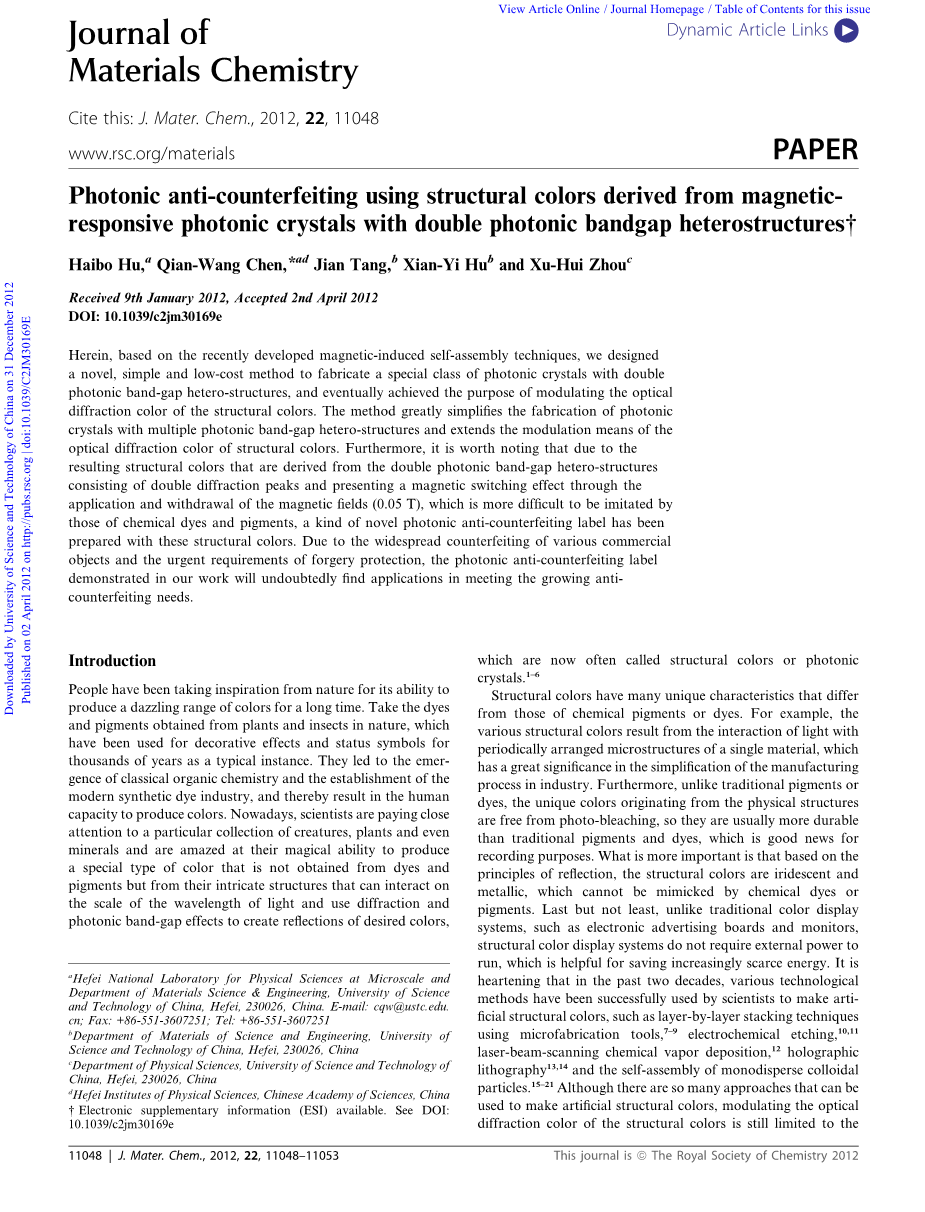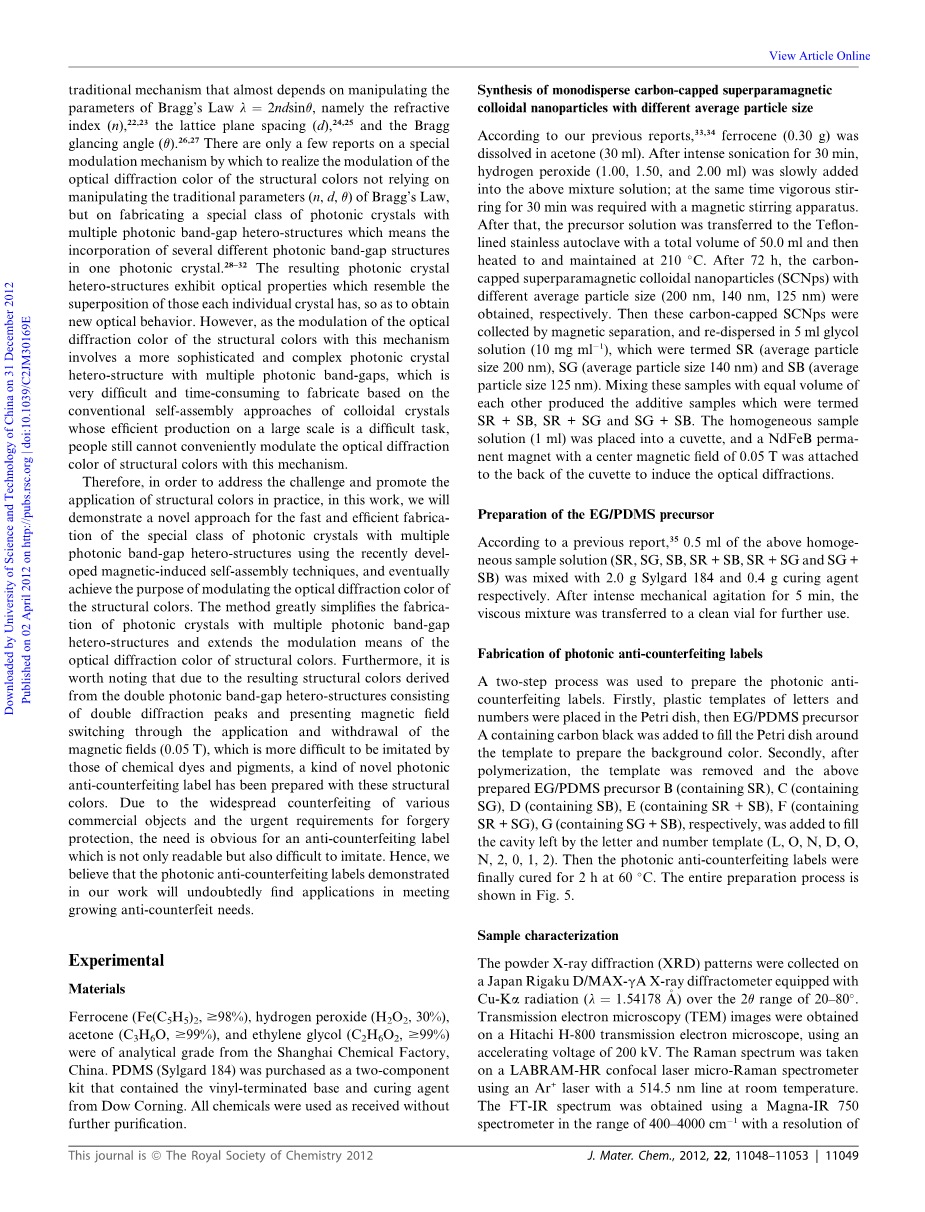

英语原文共 6 页,剩余内容已隐藏,支付完成后下载完整资料
Photonic anti-counterfeiting using structural colors derived from magnetic- responsive photonic crystals with double photonic bandgap heterostructures
基于双光子带隙异质结构磁响应光子晶体的光学防伪
Herein, based on the recently developed magnetic-induced self-assembly techniques, we designed a novel, simple and low-cost method to fabricate a special class of photonic crystals with double photonic band-gap hetero-structures, and eventually achieved the purpose of modulating the optical diffraction color of the structural colors. The method greatly simplifies the fabrication of photonic crystals with multiple photonic band-gap hetero-structures and extends the modulation means of the optical diffraction color of structural colors. Furthermore, it is worth noting that due to the resulting structural colors that are derived from the double photonic band-gap hetero-structures consisting of double diffraction peaks and presenting a magnetic switching effect through the application and withdrawal of the magnetic fields (0.05 T), which is more difficult to be imitated by those of chemical dyes and pigments, a kind of novel photonic anti-counterfeiting label has been prepared with these structural colors. Due to the widespread counterfeiting of various commercial objects and the urgent requirements of forgery protection, the photonic anti-counterfeiting label demonstrated in our work will undoubtedly find applications in meeting the growing anti- counterfeiting needs.
本文基于近年来发展起来的磁致自组装技术,设计了一种新颖、简单、低成本的制备一类具有双光子带隙异质结构的特殊光子晶体的方法,最终实现了光学衍射结构色的调制。该方法大大简化了具有多个光子带隙异质结构的光子晶体的制备,扩展了光学衍射结构色的调制方法。此外,值得注意的是,由于产生的结构性色彩源于双光子带隙异质结构组成的双衍射峰,施加磁场(磁场强度0.05 T)和撤出磁场,表现出磁控开/关效应,这难以被化学染料和颜料模仿,一种新型的光子防伪标签已经准备好利用这种结构色。由于各类商业物品的仿冒现象普遍存在和防伪保护的迫切要求,防伪标签的必要性是显而易见的,防伪标签不仅要具有可读性,而且还要难以仿造,其此,我们相信在我们的工作中展示的光学防伪标签,无疑会在日益增长的防伪需求中得到应用。
People have been taking inspiration from nature for its ability to produce a dazzling range of colors for a long time. Take the dyes and pigments obtained from plants and insects in nature, which have been used for decorative effects and status symbols for thousands of years as a typical instance. They led to the emer- gence of classical organic chemistry and the establishment of the modern synthetic dye industry, and thereby result in the human capacity to produce colors. Nowadays, scientists are paying close attention to a particular collection of creatures, plants and even minerals and are amazed at their magical ability to produce a special type of color that is not obtained from dyes and pigments but from their intricate structures that can interact on the scale of the wavelength of light and use diffraction and photonic band-gap effects to create reflections of desired colors, which are now often called structural colors or photonic crystals.
长久以来,人们一直从大自然中获得灵感,因为大自然能够创造出令人眼花缭乱的色彩。以自然界中植物和昆虫的染料和色素为例,它们几千年来一直被用作装饰和地位的象征。它们促使了古典有机化学的出现和现代合成染料工业的建立,从而引导人类对颜色进行生产。现在,科学家们正在密切关注特定的生物,甚至植物和矿物质,惊讶于它们通过复杂的结构显现颜色,而不是从染料和颜料中获得的一种特殊的颜色,可以在光的波长范围内相互作用,利用衍射和光子带隙效应反射所需要的颜色,现在通常被称为结构色或光子晶体。
Structural colors have many unique characteristics that differ from those of chemical pigments or dyes. For example, the various structural colors result from the interaction of light with periodically arranged microstructures of a single material, which has a great significance in the simplification of the manufacturing process in industry. Furthermore, unlike traditional pigments or dyes, the unique colors originating from the physical structures are free from photo-bleaching, so they are usually more durable than traditional pigments and dyes, which is good news for recording purposes. What is more important is that based on the principles of reflection, the structural colors are iridescent and metallic, which cannot be mimicked by chemical dyes or pigments. Last but not least, unlike traditional color display systems, such as electronic advertising boards and monitors, structural color display systems do not require external power to run, which is helpful for saving increasingly scarce energy. It is heartening that in the past two decades, various technological methods have been successfully used by scientists to make arti- ficial structural colors, such as layer-by-layer stacking techniques using microfabrication tools,electrochemical etching, laser-beam-scanning chemical vapor deposition, holographic lithography and the self-assembly of monodisperse colloidal particles. Although there are so many approaches that can be used to make artificial structural colors, modulating the optical diffraction color of the structural colors is still limited to thetraditional mechanism that almost depends on manipulating the parameters of Braggrsquo;s Law l frac14; 2ndsinq, namely the refractive index (n), the lattice plane spacing (d), and the Bragg glancing angle (q). There are only a few reports on a special modulation mechanism by which to realize the modulation of the optical diffraction color of the structural colors not relying on manipulating the traditional parameters (n, d, q) of Braggrsquo;s Law, but on fabricating a special class of photonic crystals with multiple photonic band-gap hetero-structures which means the incorporation of several different photonic band-gap structures in one photonic crystal. The resulting photonic crystal hetero-structures exhibit optical properties which resemble the superposition of those each individual crystal has, so as to obtain new optical behavior. However, as the modulation of the optical diffraction color of the structural colors with this mechanism involves a more sophisticated and complex photonic crystal hetero-structure with multiple photonic band-gaps, which is very difficult and time-consuming to fabricate based on the conventional self-assembly approaches of colloidal crystals whose efficient production on a large scale is a difficult task, people still cannot convenie
全文共28786字,剩余内容已隐藏,支付完成后下载完整资料
资料编号:[831]
您可能感兴趣的文章
- 通过对奥美拉唑合成反应的监测和定量反应的在线拉曼光谱和表征组件外文翻译资料
- 无金属碳基催化剂的研究进展外文翻译资料
- 钼酸钙/碳三维复合材料可控设计合成的研究外文翻译资料
- 生物催化选择性合成功能化喹唑啉酮衍生物外文翻译资料
- 三元V Zr Al ON氧氮化物-3-甲基吡啶氨氧化的高效催化剂外文翻译资料
- 综述纳米零价铁(nZVI)的合成,特性和在环境修复中的应用外文翻译资料
- 自消毒PVC表面使用点击化学设计外文翻译资料
- 微波辅助直接合成4H-1,2,4-苯并噻二嗪1,1-二氧化物衍生品外文翻译资料
- 微波辅助下直接合成1,1-二氧代-4H-1,2,4-苯并噻二嗪类衍生物外文翻译资料
- 压力选择在变压精馏中的重要性外文翻译资料


